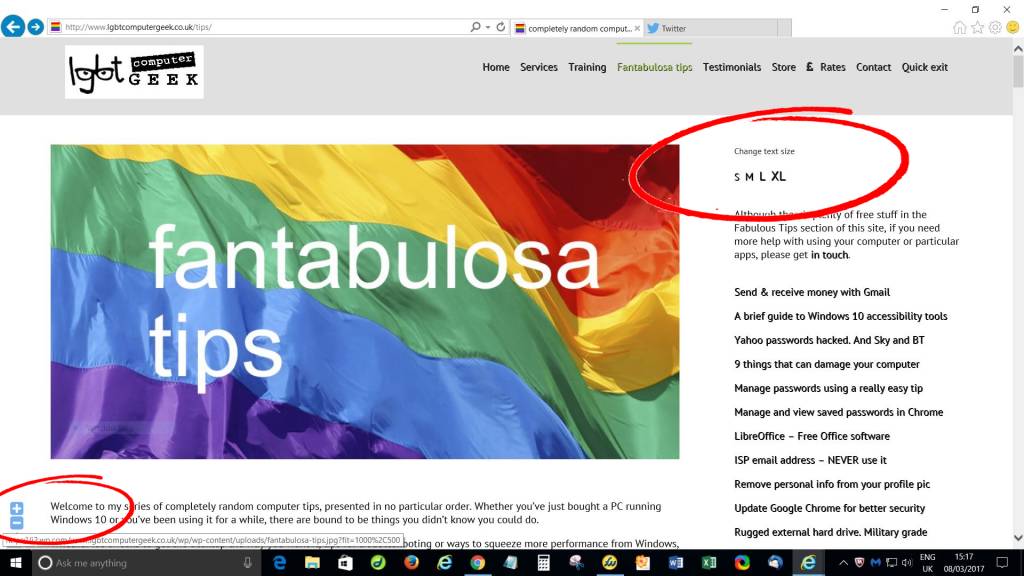Windows has always offered its users some accessibility tools. As computers have become more powerful, and big tech companies have become more aware of the needs of their users, the scope and range of tools Microsoft provide have increased. The accessibility options that are available in Windows have been designed to help people that have difficulty using a computer because of a condition or impairment, but there are plenty of interesting options that could prove incredibly useful to everyone. We will reveal how the Ease of Access Center could help you.
But what tools are available specifically? And how can you use them? Some of my clients are surprised that you can zoom into the content on a webpage, which can often make small text easier to read. In this post, I’m going to walk you through all the accessibility apps and give you a quick lesson on their usage.
The Ease of Access tab in Windows 10 is similar to the Ease of Access section in the Windows 8 PC settings menu (Charms bar > Settings > Change PC settings > Ease of Access), but with a couple of extra sections.
How to zoom with a web browser
This isn’t a Windows accessibility tool, but I’m including it because it’s so damn useful, and easy to use. Internet accessibility is important even if you are not suffering a visual impairment. Web pages should be designed with this in mind. Early web browsers were able to increase text size but not pictures or much dynamic content. Modern web browsers recognize this accessibility need and offer features to increase the size of text and pictures.
Method 1 – using keyboard shortcuts
Select the page you want to zoom out of by clicking on it. This method is best for most users. It’s the quickest and easiest, especially for laptop users without a mouse.

Press and hold the Ctrl key.

Hit the +, at the top of the keyboard, to the right of the number zero button. Alternatively, press and hold Ctrl and scroll up or down. Watch your screen and see what happens.
Method 2 – using a mouse of trackpad
Select the page you want to zoom out of by clicking on it. This can be more challenging on a laptop’s trackpad as it’s difficult to control, but mouse users may prefer this method.

Press and hold the CTRL key.

Scroll the mouse wheel or trackpad up or down.
There are other ways of doing this – please ask me during a one-to-one session.
And just in case you struggle with using the above tips to enlarge screen content, lgbt computer geek has two ways of easily adjusting the size of text and image on most of its pages. In the image below, they’re highlighted with a red scribble. If hadn’t noticed them, scroll up to the top of this page, and look at the top right edge of the screen. Or click here to get you there.

Accessibility tools: Narrator
You’ll find almost the accessibility tools hidden in a new Ease of Access menu within the Windows 10 Settings app. Navigate to Start > Settings > Ease of Access to see what’s available.
The first tool on the list is Narrator. If you suffer from poor vision, it’s a vital weapon in your armory. If set up correctly and used in conjunction with some other tools I will cover later, it’ll allow you to interact with your PC without the need for a screen.

The tool can read notifications, websites, text you type, and in-app content out loud. If you really struggle with your sight, it can even recite every individual keyboard character back to you as you press it.
You can customise further settings such as reading speed, pitch, voice and more by going to Start > Settings > Ease of Access > Narrator.
Magnifier
Magnifier is one of the accessibility tools specifically for users with poor eyesight, though it’s useful for anyone who needs focus on a tiny fraction of their screen for any reason.
You can turn Magnifier on by navigating to Start > Settings > Ease of Access > Magnifier. You will find additional settings in this menu. For example, you can invert the colors and choose whether Magnifier should track your mouse or keyboard.
Once it’s running, you’ll see a magnifying glass on your screen — it’s the in-app settings menu. Clicking on the + or – icon will zoom further in or out, while the View menu lets you decide whether you want the app to run full-screen, docked, or in lens mode.

2 ways to stop Magnifier in Windows 10
Step 1: Click the magnifier icon on the screen.
Step 2: In the pop-up Magnifier window, tap the Close button.

Way 2: Stop it using keyboard shortcuts.
Press Windows+Esc on the keyboard.
High Contrast
The next tool on the list is High Contrast. It lets you put specific parts of your screen into a hi-vis mode. Go to Start > Settings > Ease of Access > High Contrast to instigate the setup process.
To begin, you’ll need to activate one of the default high contrast themes. You have four to choose from; High Contrast #1, High Contrast #2, High Contrast Black, and High Contrast White.
Once you’ve selected one, you can customize the colors used. You can modify the colors for text, hyperlinks, disabled text, selected text, button text, and background.
When you’ve made your selections, click Apply. Windows will take a few seconds to update your preferences.
Here’s what High Contrast #1 looks like when used on Windows 10 Settings app:

Closed Captions
Many people find it difficult to read poorly designed subtitles, e.g. white subtitles on a TV show or movie, especially if the background is very light. Closed captions let you read the words that are spoken in the audio part of a video or television show. When closed captioning is turned on, closed captions are usually displayed at the bottom of the screen. Closed captions are often used by people with hearing disabilities and by viewers who would rather read than listen to the audio portion of a video.
Closed Captions — lets you edit the colors and backgrounds of your subtitles. Your settings will be applied to any caption text on any supported local media player.

You can choose the caption’s colour, transparency, style, size, effects; the background colour and transparency; and the window’s colour and transparency. Only eight colours (white, black, red, green, blue, yellow, magenta, cyan) are available. You can see a live preview of any changes you make in the example text at the top of the screen.
Keyboard
The Keyboard tool, part of the accessibility tools screen, has four separate mini-tools within it. They are:
- On-Screen Keyboard — Gives you a graphical keyboard on your computer screen that you can operate using the mouse.
- Sticky Keys — Sticky keys let you press one key at a time for keyboard shortcuts rather than having to hold down multiple keys. For example, CTRL + C (copy) would become press CTRL [and release], press C [and release].
- Toggle Keys — Every time you press one of the toggle keys (caps lock, num lock, scroll lock, and on some PCs, function lock), you will hear a sound.
- Filter Keys — You can choose to prevent your keyboard from repeating keys if you tend to keep your finger pressed down too long. Enabling the setting will give you further sub-settings you can adjust.

Mouse
It’s fair to say the accessibility tools for the mouse are probably the weakest in the line-up. The Settings app limits you to changing the pointer size, pointer color, and a couple of usage settings such as allowing the num pad to move the mouse around the screen.
For extra mouse options, it’s wise to see what’s available in your Mouse Properties. To access the Properties menu, go to Start > Settings > Devices > Mouse and Touchpad > Related Settings > Additional Mouse Options.

The available settings will vary from mouse to mouse, but you should see options to enable ClickLock (to make drag-and-drop easier), change the speed of the pointer, add a trail to your pointer, and adjust the double-click speed.
Speech Recognition
One accessibility tool is not found within the Ease of Access menu: the Speech Recognition app.
The app will listen to all your spoken words and translate them into on-screen actions. You can use it to dictate documents, navigate menus, and even surf the web.

Explaining how to set up and use the app is beyond the scope of this article, but if you need help in setting this up, please contact me, and indeed, if you want a one-to-one tutorial for yourself or someone else on using the various ease of access features of Windows, please give me a shout.


